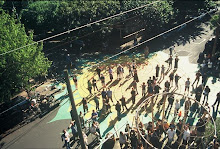Before the holidays, the City Repair office hosted Portland FreeSkool's Fermentation Festival and it was pretty amazing... i demonstrated yogurt and ginger beer making. Others demonstrated Kimchi, Sauerkraut, Kombucha, beer & wine making, and perhaps other recipes i can't remember.
Here's my two recipes for your enjoyment:
Home fermented Ginger Beer (a strong ginger ale) Water
4-8 inches of fresh ginger root
2 cups sugar (or honey)
2 lemons
Make a ginger starter: Put about 1 cup of water in a small mason jar, add 2 tsp of sugar and 2 tsp of fresh grated ginger root. Cover the jar with cheese cloth and a rubber band so that wild yeast can fall in, but bugs will stay out. Every day or two feed the starter: add about 2 tsps more sugar and ginger... after 2-7 days, you'll see the starter is active (tiny bubbles forming at the edges), meaning you have enough yeast to start the ginger ale. My guess is ithe longer you wait and continue to feed the starter the more and vigorous the yeast is so it will ferment/multiply quicker...and ultimately lead to quicker ginger ale.... I haven't proven this fully yet, but that seems to be the trend i'm noticing as I make ginger ale. I try to let the starter go 5-7 days.
After the starter is active, start your main ginger ale brew in a separate container...a 1gal pot or larger. Add 2 quarts (½ gallon) water, 2-6 inches of grated ginger root and 1 ½ cups sugar (or honey). To get something like the strong Reed's Ginger Beer brew, use a lot of ginger (5-6 inches)... if you want it milder, try 2-4 inches. Bring this mix to a boil and boil for ~ 15minutes. Let it cool. Add the juice of 2 lemons. Strain out the ginger from both the starter and the main ginger brew. Combine the starter with the brew and add enough water to get 1 gallon. Now you're ready to bottle it. Use a 1 gallon growler with screw on lid, or separate screw top glass bottles in ~ 750mL (5 of em) or 1L capacities (4 of em). Now, let the brew sit in the bottle for a minimum of 2 weeks (at least 4 weeks if you're using honey) in a warm spot, like on a high shelf or on top of the fridge. The longer you wait, the more bubbly it will be. Refrigerate and serve.
Using honey takes much longer to ferment than table sugar, it's also better for us, many would say. I only replace the main brew sugar (the 1 ½ cups) with honey. I still used the small amount of sugar in the starter to make sure it got going reliably and within a week. The fermentation process produces just enough CO2 to carbonate the soft drink and not an appreciable level of alcohol...so it's just a homemade, carbonated soft drink.
Reference: the book, Wild Fermentation - my addition is using honey, which I've tried. Taste's great and i'm not a huge honey fan.
Homemade Yogurt... yum!

** The only thing special you need is a small (6-pack soda size) cooler to keep the milk warm for several hours.
Milk 1-2 Qts
2 TBS of any yogurt with live active cultures
any sweetener (sugar, maple syrup, honey)(optional) other flavor ingredients like fruit, vanilla extract, etc.1 or 2 QT mason jar
small 6-pack cooler
Scald the milk (heat till bubbles form at the edges, but don't boil), let it cool to luke warm. Put 2 TBS of yogurt into a mason jar, pour the lukewarm milk over it. add any sweetener, fruit, etc. Stir it. Put the mason jar (no lid) into the cooler and add warm water to the cooler (around the mason jar) to the level of the milk. you don't want the mason jar to float. Put the lid on the cooler and wait 8-10 hours. then remove the yogurt, add a lid and refrigerate (it should be fairly thick, but will thicken further after refrigeration).
Other tips:
- the yogurt will get a little thicker after refrigeration
- don't use more than 2TBS of yogurt starter...for some reason if you use more, the culture doesn't take off well and the yogurt might not 'gel' right
- to keep making yogurt, save 2 TBS from the yogurt you make. Also, if you go away on a trip or let the yogurt go bad, you can always put 2 TBS or so of yogurt in the freezer and take it out of the freezer to make a new batch. starter still works after unfrozen. so you don't have to go back to the store for more yogurt as a starter.
- i haven't tried adding fruit...only sweetener and vanilla extract
- An easier method without the cooler: Deepak's mom mentioned that her method is like mine, but she leaves a bowl of the yogurt covered on the counter overnight and it works just fine too; and she brings the milk to a boil, not just scalding it – I haven't tried this method yet, but will soon.
 ...that is if you have a composting or sawdust toilet. But, it might be worth trying in a flush toilet....of course they say you can't use anything but TP. who knows, i don't.
...that is if you have a composting or sawdust toilet. But, it might be worth trying in a flush toilet....of course they say you can't use anything but TP. who knows, i don't.











